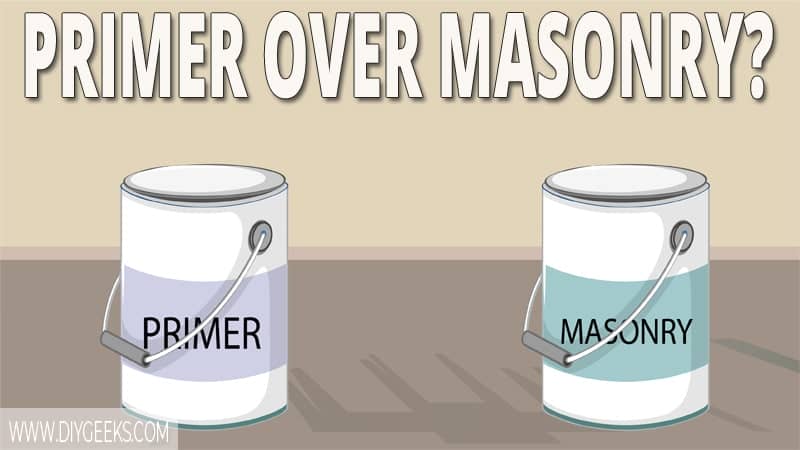A primer is designed to be an undercoat, cover the imperfections in the surface, and provide a smooth finish for the next paint to stick to.
Masonry paint does need a primer before it’s applied to increase moisture retention, cover holes, and stick better. The finish won’t stick and will peel off if you apply masonry without an undercoat on rough surfaces.
Can You Paint Directly Over Masonry?
You can’t paint directly over masonry as its bare surface isn’t ideal for paint application. The coating won’t stick and the finish will be riddled with imperfections and peel off if you apply paint directly over masonry.
Masonry is one of the toughest finishes in building and construction. Its finish is made from a combination of materials like rocks, sand, cement, and the like. All of these materials are mixed to produce a finish with improved moisture retention. This means that it does well to hide and retain water.
Masonry does well to hide and retain water — so if you paint over it without a primer the new coating will be severely affected by moisture. The moisture will prevent the new coating from sticking or drying.
Masonry finishes are usually rough and riddled with cracks, holes, and other imperfections — so if you paint directly over it the new finish will be rough and bumpy (if it sticks).
Do You Need an Undercoat Before Painting Over Masonry Paint?
You need an undercoat before painting over masonry paint or surface to improve the adhesion and get a fine finish. Without an undercoat, the finish will have bumps and eventually peel off.
The undercoat or primer seals the surface underneath, prevents moisture from affecting the coating, and provides a smooth layer for the paint to stick to.
Masonry surfaces are porous due to cracks, so you must apply a primer to cover these holes and prevent wastage. The rough finish of masonry paint doesn’t allow the paint to stick — an undercoat will cover this rough finish and produce a smooth undercoat to improve adhesion.
Does Masonry Paint Need a Top Coat?
Masonry paint doesn’t need a topcoat or sealer as it’s designed with protective additives given the type of material and environment they are used in.
Masonry paint has a thick finish when dry that is durable enough and prevents topcoats (sealers) from adhering well.
However, you must seal acrylic or latex masonry paint to prevent the colors from fading due to weather elements. That’s because they are water-based and not durable.
Since masonry paint is used on concrete, brick, stucco, and cinder blocks, the paint is formulated with extra additives to be strong and durable. This means it will last longer than most types of paints.
Does Sandtex Masonry Paint Need a Primer?
Sandtex masonry paint needs a primer if applied over rough surfaces. Although this paint uses micro-seal technology to provide a durable finish, a primer coating will only help it stick better.
You must apply a primer coating if the surface is riddled with holes, cracks, pores, and other imperfections. These imperfections will suck (absorb) more paint than needed if you don’t apply an undercoat.
For very rough surfaces, except for the primer coating, you must apply Sandtex-ready mixed filler, too. The filler is used to repair masonry before you apply the paint. The filler can also be used as a primer (basecoat).
For smooth, clean, and surfaces with no imperfections, you can apply Sandtex masonry paint without a primer or undercoat.
To know if you need a primer, test the Sandtex tester pots. The tester pots are small cans that have different paint types for masonry. You can try them on masonry without a primer and check out each finish.
What Type of Primer To Use For Masonry Paint?
Use an epoxy concrete primer for masonry paint as it will adhere to rough surfaces better and create a firm and smooth undercoat. Epoxy concrete primer will seal the surface and cover imperfections that can over-absorb the paint.
Epoxy concrete primer is oil-based and has extra additives that help it stick to the surface better than water-based primers.
To prep a surface before masonry paint, you must use a primer that is designed to seal and repair tough surfaces and has enough resins and additives to stick to these surfaces. Oil-based primers have all of these things, while water-based don’t.
What Happens If You Don’t Apply Primer Before Painting Masonry?
If you don’t apply primer before painting masonry the coating(s) will peel off. This is because the rough and wet surface will prevent the paint from drying and particles from bonding together.
Since the paint particles won’t bond, they will be separated and cure (dry) in different segments. The separation occurs due to the presence of edges and bumps in the masonry. These edges and bumps poke out of the coating after it is applied. Over time, the finish will appear torn.
This will create gaps in the coating that will make it more susceptible to moisture and friction. The finish will eventually start to peel off the surface.
Sure, you can apply more coats to seal these edges but doing this will just result in wastage and uneven application. Also, the coating will not dry evenly and there will be color variations. The only way out of this is to prime the masonry before the paint is applied.
[su_youtube url=”https://www.youtube.com/watch?v=MUTFAut-9jA”]
Things To Know
How Many Coats of Primer Over Masonry?
You need only 1 coat of epoxy primer before applying masonry paint. However, if the surface has a lot of holes and cracks, you might need a second coat.
How Many Coats of Masonry Paint?
Apply two (2) coats of masonry paint for unfinished masonry surfaces, and one (1) coat for finished surfaces.


